Battery MITSUBISHI 380 2005 Owner's Manual
[x] Cancel search | Manufacturer: MITSUBISHI, Model Year: 2005, Model line: 380, Model: MITSUBISHI 380 2005Pages: 1500, PDF Size: 47.87 MB
Page 159 of 1500
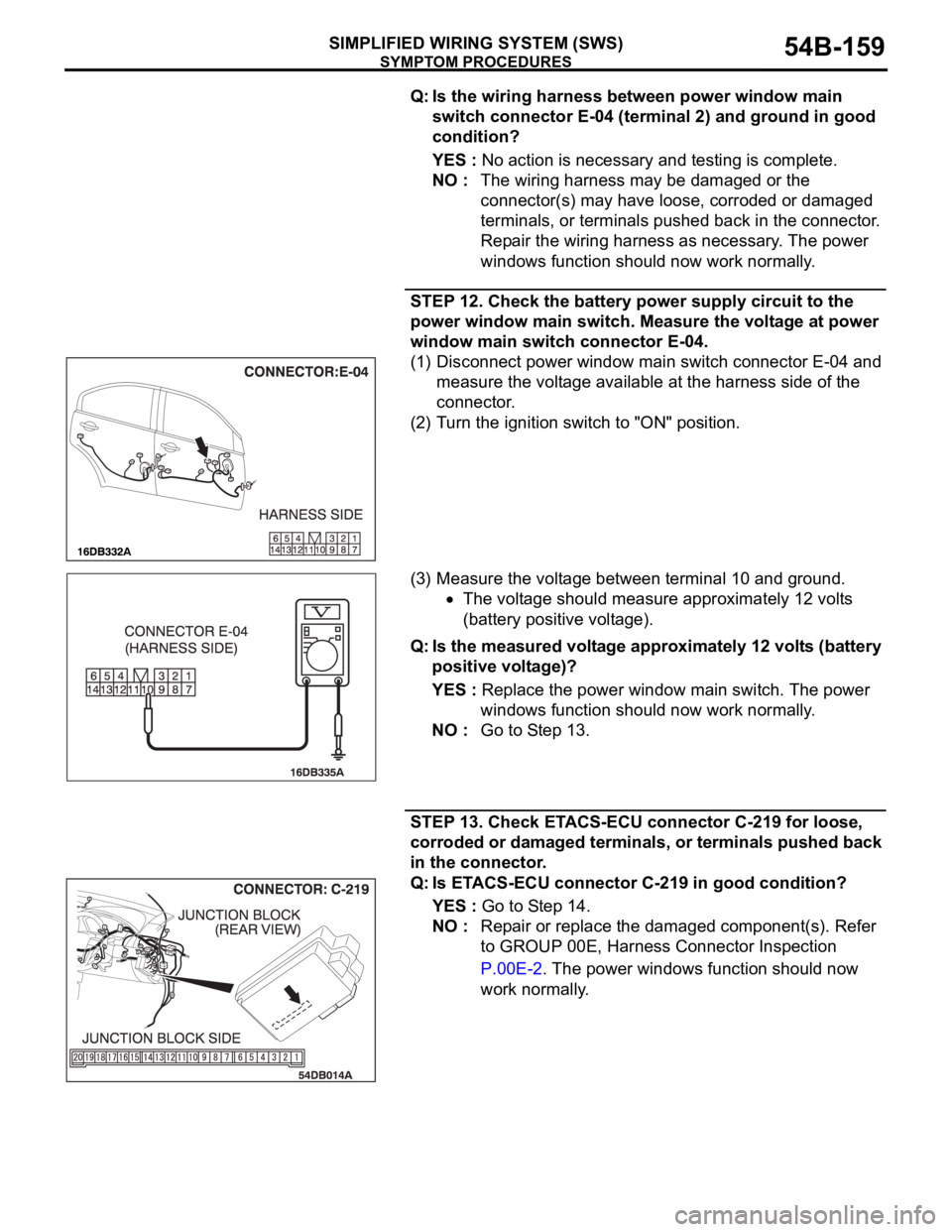
SYMPTOM PROCEDURES
SIMPLIFIED WIRING SYSTEM (SWS)54B-159
Q: Is the wiring harness between power window main
switch connector E-04 (terminal 2) and ground in good
condition?
YES : No action is necessary and testing is complete.
NO : The wiring harness may be damaged or the
connector(s) may have loose, corroded or damaged
terminals, or terminals pushed back in the connector.
Repair the wiring harness as necessary. The power
windows function should now work normally.
STEP 12. Check the battery power supply circuit to the
power window main switch. Measure the voltage at power
window main switch connector E-04.
(1) Disconnect power window main switch connector E-04 and
measure the voltage available at the harness side of the
connector.
(2) Turn the ignition switch to "ON" position.
(3) Measure the voltage between terminal 10 and ground.
The voltage should measure approximately 12 volts
(battery positive voltage).
Q: Is the measured voltage approximately 12 volts (battery
positive voltage)?
YES : Replace the power window main switch. The power
windows function should now work normally.
NO : Go to Step 13.
STEP 13. Check ETACS-ECU connector C-219 for loose,
corroded or damaged terminals, or terminals pushed back
in the connector.
Q: Is ETACS-ECU connector C-219 in good condition?
YES : Go to Step 14.
NO : Repair or replace the damaged component(s). Refer
to GROUP 00E, Harness Connector Inspection
P.00E-2. The power windows function should now
work normally.
Page 166 of 1500
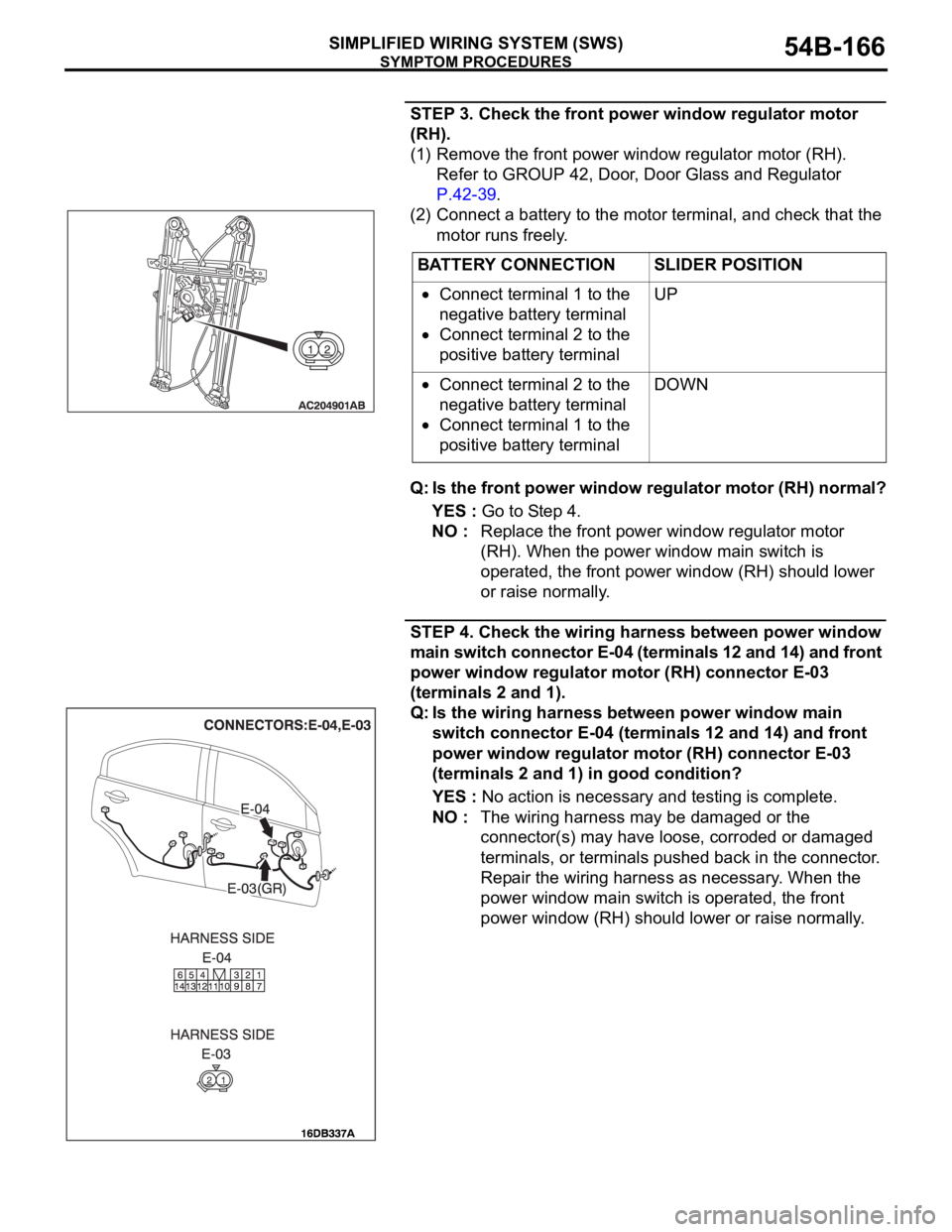
SYMPTOM PROCEDURES
SIMPLIFIED WIRING SYSTEM (SWS)54B-166
STEP 3. Check the front power window regulator motor
(RH).
(1) Remove the front power window regulator motor (RH).
Refer to GROUP 42, Door, Door Glass and Regulator
P.42-39.
(2) Connect a battery to the motor terminal, and check that the
motor runs freely.
Q: Is the front power window regulator motor (RH) normal?
YES : Go to Step 4.
NO : Replace the front power window regulator motor
(RH). When the power window main switch is
operated, the front power window (RH) should lower
or raise normally.
STEP 4. Check the wiring harness between power window
main switch connector E-04 (terminals 12 and 14) and front
power window regulator motor (RH) connector E-03
(terminals 2 and 1).
Q: Is the wiring harness between power window main
switch connector E-04 (terminals 12 and 14) and front
power window regulator motor (RH) connector E-03
(terminals 2 and 1) in good condition?
YES : No action is necessary and testing is complete.
NO : The wiring harness may be damaged or the
connector(s) may have loose, corroded or damaged
terminals, or terminals pushed back in the connector.
Repair the wiring harness as necessary. When the
power window main switch is operated, the front
power window (RH) should lower or raise normally. BATTERY CONNECTION SLIDER POSITION
Connect terminal 1 to the
negative battery terminal
Connect terminal 2 to the
positive battery terminalUP
Connect terminal 2 to the
negative battery terminal
Connect terminal 1 to the
positive battery terminalDOWN
Page 171 of 1500
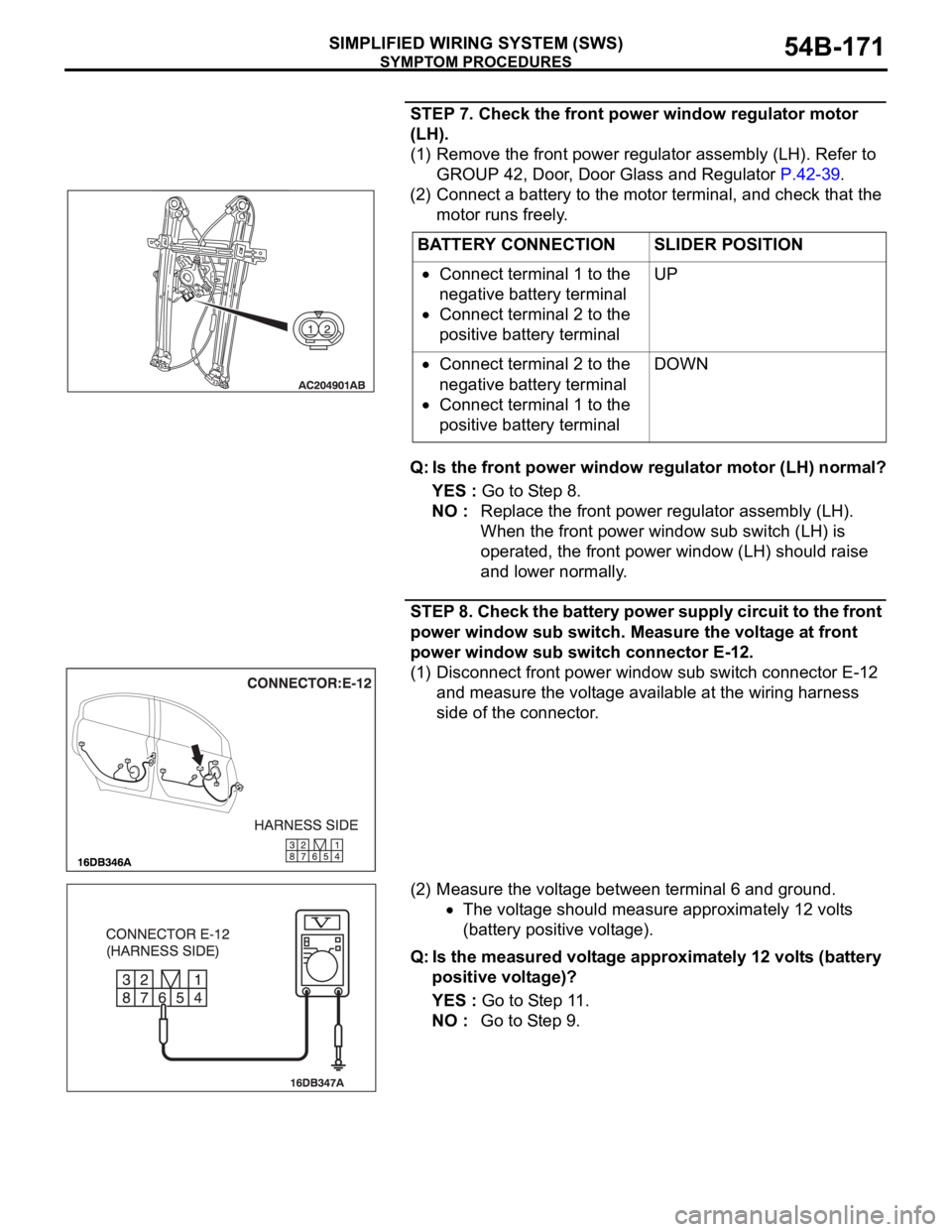
SYMPTOM PROCEDURES
SIMPLIFIED WIRING SYSTEM (SWS)54B-171
STEP 7. Check the front power window regulator motor
(LH).
(1) Remove the front power regulator assembly (LH). Refer to
GROUP 42, Door, Door Glass and Regulator P.42-39.
(2) Connect a battery to the motor terminal, and check that the
motor runs freely.
Q: Is the front power window regulator motor (LH) normal?
YES : Go to Step 8.
NO : Replace the front power regulator assembly (LH).
When the front power window sub switch (LH) is
operated, the front power window (LH) should raise
and lower normally.
STEP 8. Check the battery power supply circuit to the front
power window sub switch. Measure the voltage at front
power window sub switch connector E-12.
(1) Disconnect front power window sub switch connector E-12
and measure the voltage available at the wiring harness
side of the connector.
(2) Measure the voltage between terminal 6 and ground.
The voltage should measure approximately 12 volts
(battery positive voltage).
Q: Is the measured voltage approximately 12 volts (battery
positive voltage)?
YES : Go to Step 11.
NO : Go to Step 9. BATTERY CONNECTION SLIDER POSITION
Connect terminal 1 to the
negative battery terminal
Connect terminal 2 to the
positive battery terminalUP
Connect terminal 2 to the
negative battery terminal
Connect terminal 1 to the
positive battery terminalDOWN
Page 176 of 1500

SYMPTOM PROCEDURES
SIMPLIFIED WIRING SYSTEM (SWS)54B-176
STEP 16. Check the rear power window regulator motor
(LH).
(1) Remove the rear power window regulator assembly (LH).
Refer to GROUP 42, Door, Door Glass and Regulator
P.42-39.
(2) Connect a battery to the motor terminal, and check that the
motor runs freely.
Q: Is the rear power window regulator motor (LH) normal?
YES : Go to Step 17.
NO : Replace the rear power regulator assembly (LH).
When the rear power window sub switch (LH) is
operated, the rear power window (LH) should raise
and lower normally.
STEP 17. Check the battery power supply circuit to the rear
power window sub switch (LH). Measure the voltage at rear
power window sub switch (LH) connector E-17.
(1) Disconnect rear power window sub switch (LH) connector
E-17 and measure the voltage available at the wiring
harness side of the connector.
(2) Measure the voltage between terminal 6 and ground.
The voltage should measure approximately 12 volts
(battery positive voltage).
Q: Is the measured voltage approximately 12 volts (battery
positive voltage)?
YES : Go to Step 20.
NO : Go to Step 18. BATTERY CONNECTION SLIDER POSITION
Connect terminal 1 to the
negative battery terminal
Connect terminal 2 to the
positive battery terminalUP
Connect terminal 2 to the
negative battery terminal
Connect terminal 1 to the
positive battery terminalDOWN
Page 182 of 1500
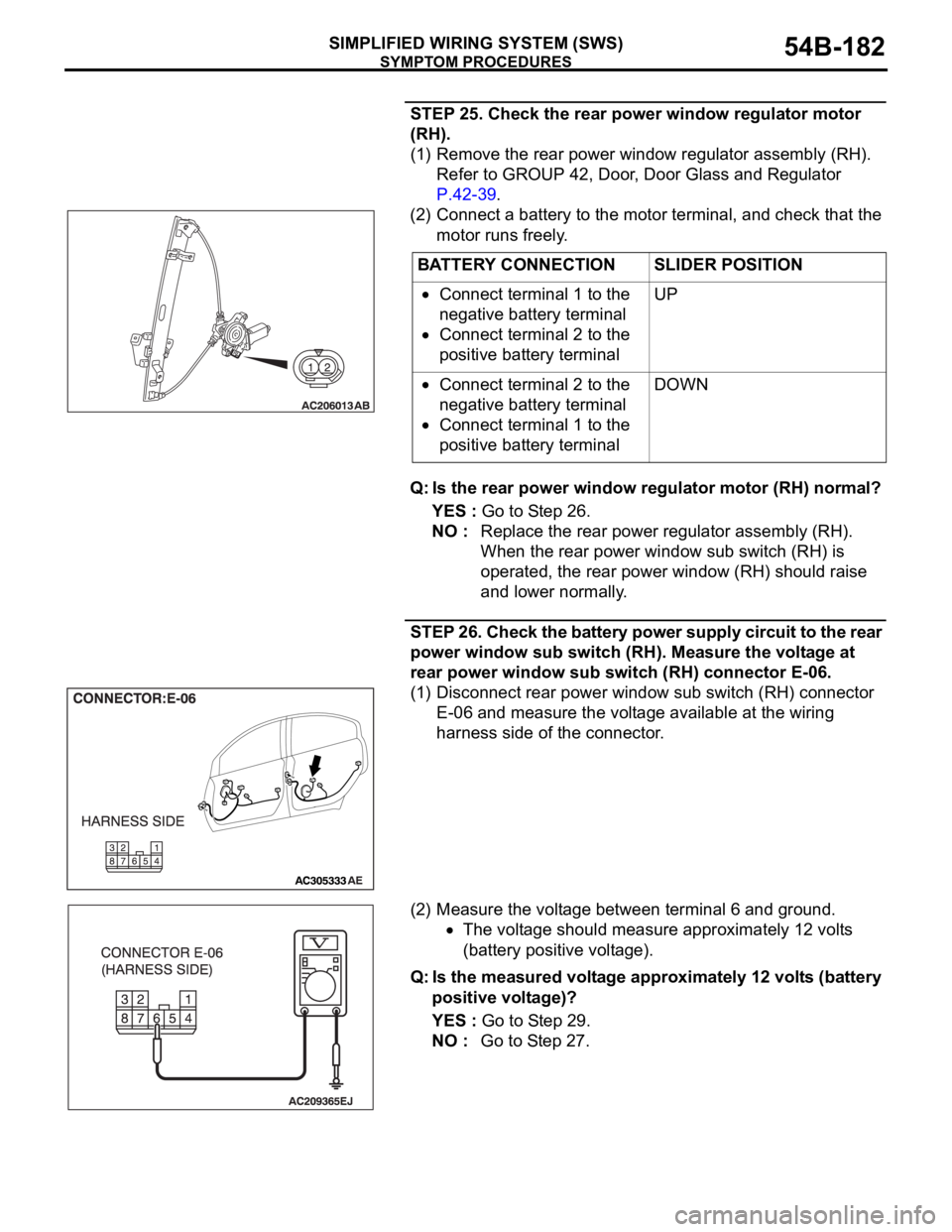
SYMPTOM PROCEDURES
SIMPLIFIED WIRING SYSTEM (SWS)54B-182
STEP 25. Check the rear power window regulator motor
(RH).
(1) Remove the rear power window regulator assembly (RH).
Refer to GROUP 42, Door, Door Glass and Regulator
P.42-39.
(2) Connect a battery to the motor terminal, and check that the
motor runs freely.
Q: Is the rear power window regulator motor (RH) normal?
YES : Go to Step 26.
NO : Replace the rear power regulator assembly (RH).
When the rear power window sub switch (RH) is
operated, the rear power window (RH) should raise
and lower normally.
STEP 26. Check the battery power supply circuit to the rear
power window sub switch (RH). Measure the voltage at
rear power window sub switch (RH) connector E-06.
(1) Disconnect rear power window sub switch (RH) connector
E-06 and measure the voltage available at the wiring
harness side of the connector.
(2) Measure the voltage between terminal 6 and ground.
The voltage should measure approximately 12 volts
(battery positive voltage).
Q: Is the measured voltage approximately 12 volts (battery
positive voltage)?
YES : Go to Step 29.
NO : Go to Step 27. BATTERY CONNECTION SLIDER POSITION
Connect terminal 1 to the
negative battery terminal
Connect terminal 2 to the
positive battery terminalUP
Connect terminal 2 to the
negative battery terminal
Connect terminal 1 to the
positive battery terminalDOWN
Page 195 of 1500
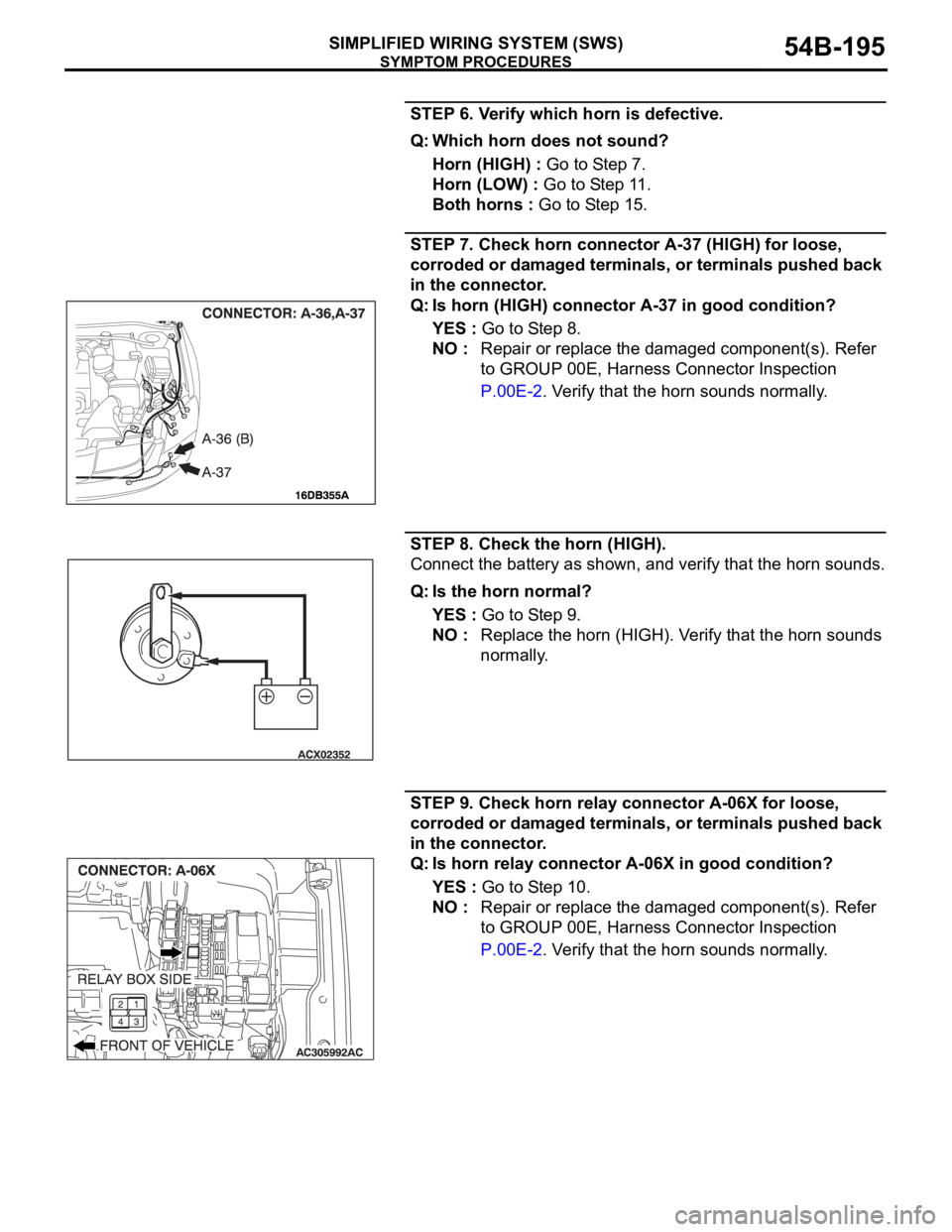
SYMPTOM PROCEDURES
SIMPLIFIED WIRING SYSTEM (SWS)54B-195
STEP 6. Verify which horn is defective.
Q: Which horn does not sound?
Horn (HIGH) : Go to Step 7.
Horn (LOW) : Go to Step 11.
Both horns : Go to Step 15.
STEP 7. Check horn connector A-37 (HIGH) for loose,
corroded or damaged terminals, or terminals pushed back
in the connector.
Q: Is horn (HIGH) connector A-37 in good condition?
YES : Go to Step 8.
NO : Repair or replace the damaged component(s). Refer
to GROUP 00E, Harness Connector Inspection
P.00E-2. Verify that the horn sounds normally.
STEP 8. Check the horn (HIGH).
Connect the battery as shown, and verify that the horn sounds.
Q: Is the horn normal?
YES : Go to Step 9.
NO : Replace the horn (HIGH). Verify that the horn sounds
normally.
STEP 9. Check horn relay connector A-06X for loose,
corroded or damaged terminals, or terminals pushed back
in the connector.
Q: Is horn relay connector A-06X in good condition?
YES : Go to Step 10.
NO : Repair or replace the damaged component(s). Refer
to GROUP 00E, Harness Connector Inspection
P.00E-2. Verify that the horn sounds normally.
Page 196 of 1500
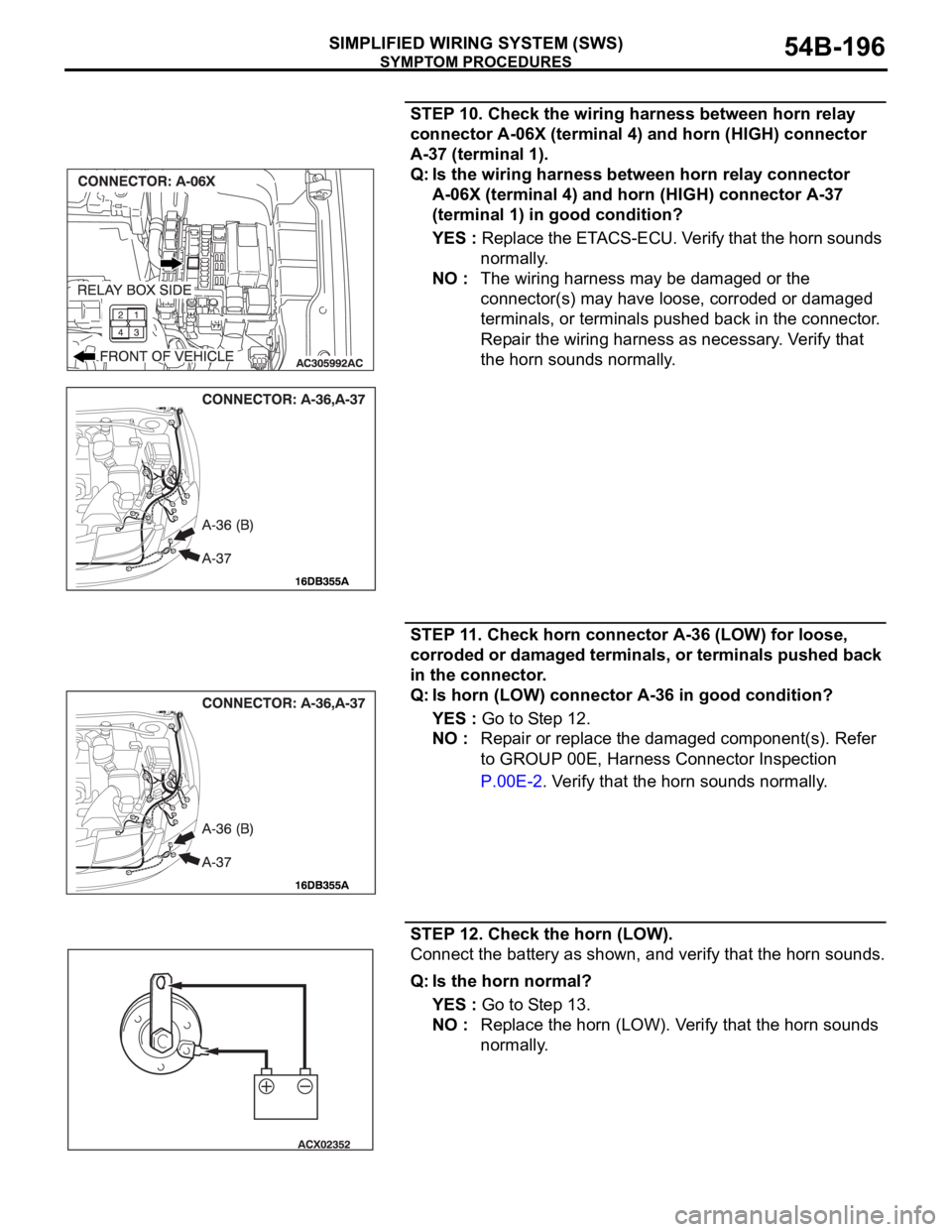
SYMPTOM PROCEDURES
SIMPLIFIED WIRING SYSTEM (SWS)54B-196
STEP 10. Check the wiring harness between horn relay
connector A-06X (terminal 4) and horn (HIGH) connector
A-37 (terminal 1).
Q: Is the wiring harness between horn relay connector
A-06X (terminal 4) and horn (HIGH) connector A-37
(terminal 1) in good condition?
YES : Replace the ETACS-ECU. Verify that the horn sounds
normally.
NO : The wiring harness may be damaged or the
connector(s) may have loose, corroded or damaged
terminals, or terminals pushed back in the connector.
Repair the wiring harness as necessary. Verify that
the horn sounds normally.
STEP 11. Check horn connector A-36 (LOW) for loose,
corroded or damaged terminals, or terminals pushed back
in the connector.
Q: Is horn (LOW) connector A-36 in good condition?
YES : Go to Step 12.
NO : Repair or replace the damaged component(s). Refer
to GROUP 00E, Harness Connector Inspection
P.00E-2. Verify that the horn sounds normally.
STEP 12. Check the horn (LOW).
Connect the battery as shown, and verify that the horn sounds.
Q: Is the horn normal?
YES : Go to Step 13.
NO : Replace the horn (LOW). Verify that the horn sounds
normally.
Page 198 of 1500
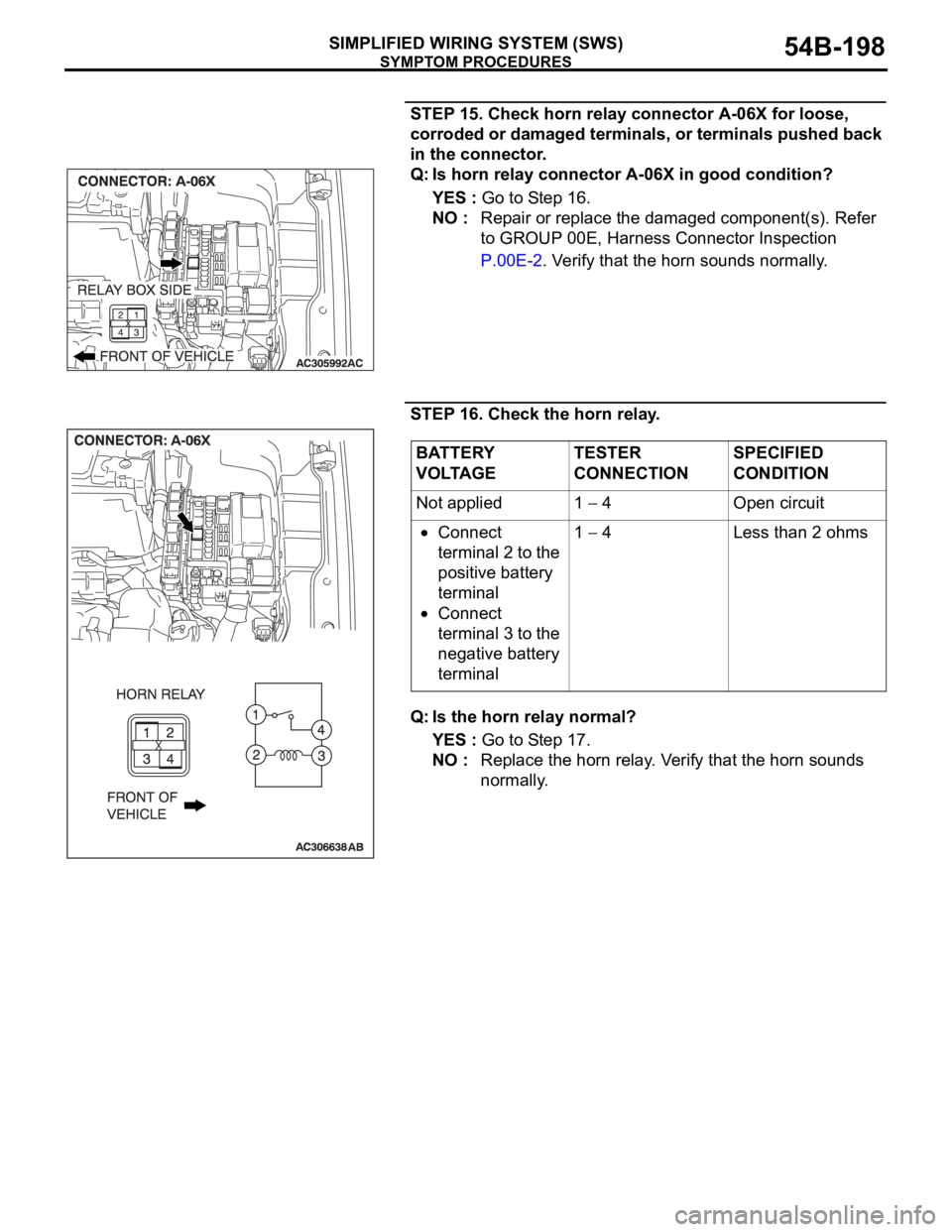
SYMPTOM PROCEDURES
SIMPLIFIED WIRING SYSTEM (SWS)54B-198
STEP 15. Check horn relay connector A-06X for loose,
corroded or damaged terminals, or terminals pushed back
in the connector.
Q: Is horn relay connector A-06X in good condition?
YES : Go to Step 16.
NO : Repair or replace the damaged component(s). Refer
to GROUP 00E, Harness Connector Inspection
P.00E-2. Verify that the horn sounds normally.
STEP 16. Check the horn relay.
Q: Is the horn relay normal?
YES : Go to Step 17.
NO : Replace the horn relay. Verify that the horn sounds
normally.
BATTERY
VOLTAGETESTER
CONNECTIONSPECIFIED
CONDITION
Not applied 1
4 Open circuit
Connect
terminal 2 to the
positive battery
terminal
Connect
terminal 3 to the
negative battery
terminal1
4 Less than 2 ohms
Page 199 of 1500
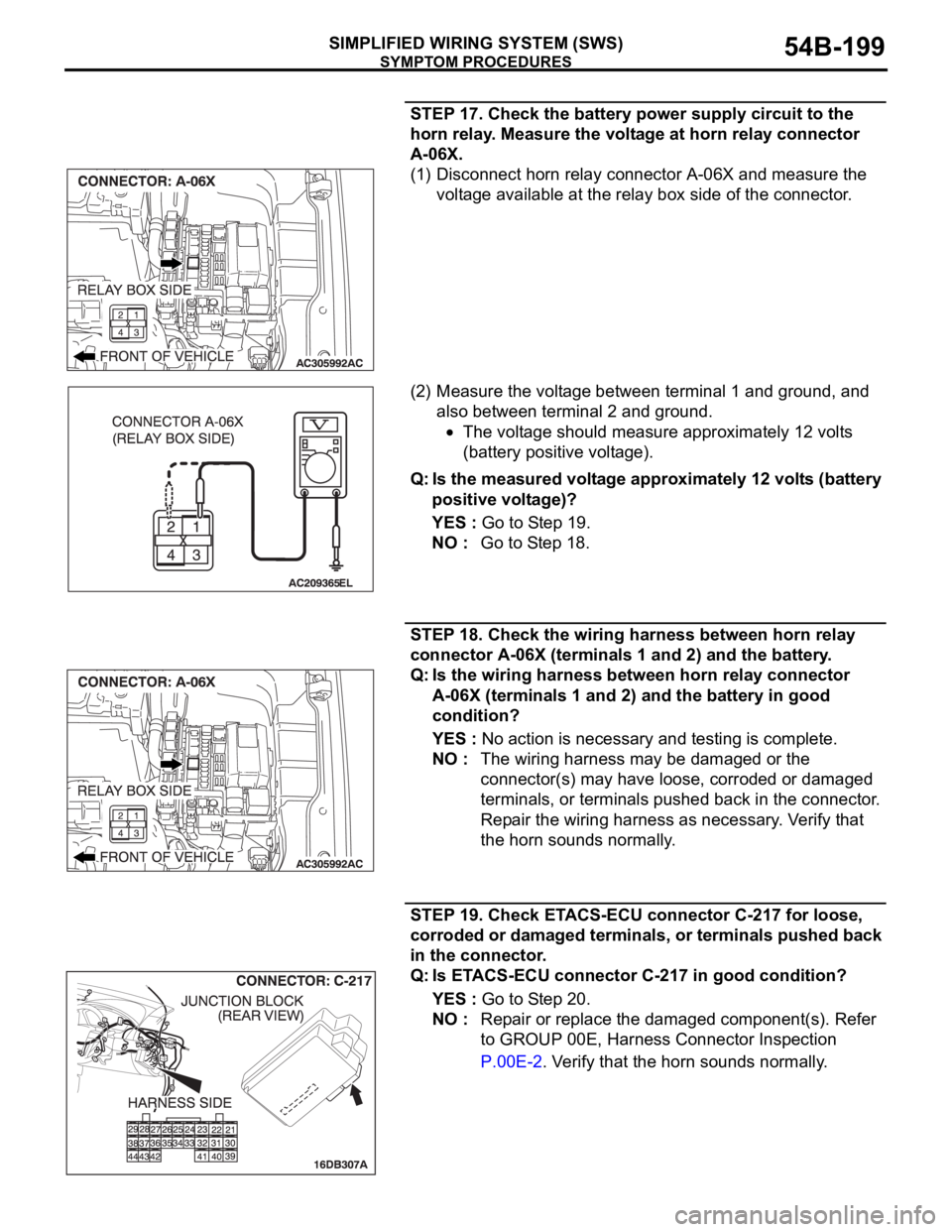
SYMPTOM PROCEDURES
SIMPLIFIED WIRING SYSTEM (SWS)54B-199
STEP 17. Check the battery power supply circuit to the
horn relay. Measure the voltage at horn relay connector
A-06X.
(1) Disconnect horn relay connector A-06X and measure the
voltage available at the relay box side of the connector.
(2) Measure the voltage between terminal 1 and ground, and
also between terminal 2 and ground.
The voltage should measure approximately 12 volts
(battery positive voltage).
Q: Is the measured voltage approximately 12 volts (battery
positive voltage)?
YES : Go to Step 19.
NO : Go to Step 18.
STEP 18. Check the wiring harness between horn relay
connector A-06X (terminals 1 and 2) and the battery.
Q: Is the wiring harness between horn relay connector
A-06X (terminals 1 and 2) and the battery in good
condition?
YES : No action is necessary and testing is complete.
NO : The wiring harness may be damaged or the
connector(s) may have loose, corroded or damaged
terminals, or terminals pushed back in the connector.
Repair the wiring harness as necessary. Verify that
the horn sounds normally.
STEP 19. Check ETACS-ECU connector C-217 for loose,
corroded or damaged terminals, or terminals pushed back
in the connector.
Q: Is ETACS-ECU connector C-217 in good condition?
YES : Go to Step 20.
NO : Repair or replace the damaged component(s). Refer
to GROUP 00E, Harness Connector Inspection
P.00E-2. Verify that the horn sounds normally.
Page 204 of 1500

SYMPTOM PROCEDURES
SIMPLIFIED WIRING SYSTEM (SWS)54B-204
STEP 3. Check the transmitter.
Q: When the transmitter's battery is replaced, can the
encrypted code be registered?
YES : No action is necessary and testing is complete.
NO : Replace the transmitter. If the encrypted code cannot
be registered using the new transmitter, replace the
ETACS-ECU. Verify that the encrypted code can be
registered in the transmitter.